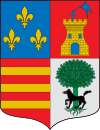Güeñes
| Güeñes | |||
|---|---|---|---|

Church of St. Mary
|
|||
|
|||
| Location of Güeñes within the Basque Country | |||
| Coordinates: 43°12′50″N 3°5′39″W / 43.21389°N 3.09417°W | |||
| Country | Spain | ||
| Autonomous community | Basque Country | ||
| Province | Biscay | ||
| Comarca | Enkarterri | ||
| Government | |||
| • Mayor | Imanol Zuluaga Zamalloa | ||
| Area | |||
| • Total | 41.16 km2 (15.89 sq mi) | ||
| Elevation | 81 m (266 ft) | ||
| Population (2011) | |||
| • Total | 8,258 | ||
| • Density | 200/km2 (520/sq mi) | ||
| Demonym(s) | Güeñés | ||
| Time zone | CET (UTC+1) | ||
| • Summer (DST) | CEST (UTC+2) | ||
| Postal code | 48840 | ||
| Website | Official website | ||
The council of Güeñes is a municipality in the county of Encartaciones (Biscay, Basque Country, Spain). It is furrowed by the waters of the river Cadagua and forms with its neighbor, the municipality of Zalla, Salcedo Valley. In the North it limits with Galdames and Baracaldo; in the east with Alonsotegui (Gran Bilbao);in the west with the municipality of Zalla and in the south with the municipality of Gordejuela. Its more important coresof population are Güeñes, Sodupe, The Quadra, Zaramillo, Sanchosolo and San Pedro of Goicouría. It deserves special artistic attention the mother church of Santa María de Güeñes.
The towns of Sodupe, La Quadra, Zaramillo and the administrative centre, Güeñes, all lie within the region.
In ancient times, it was included in the Valley of Salcedo, formed by two councils: Güeñes and Zalla. The valley of Salcedo was founded in the late 12th century by Count D. Rubio Diaz de Asturias, who ordered the building of the Tower of Salcedo of Aranguti, which was later on transformed into a palace. He was succeeded by his daughter Maria de Salcedo, married to D. Galindo de Ayala, Mr. of Ayala. Ayala and Salcedo would remain together for the rest of the 12th century and the first half of the 13th century, under the successive domination of Sancho Garcia "the headstrong" and Hurtado Sanz. They would not, however, the only eminent "owners" of the valley: other characters wielded power in the area, such as Martin Sancho de Santa Marina. In the early 13th century, Hurtado Sanz de Salcedo, (6th Lord of Ayala), had a daughter who had two bastard children with Martin Sanchez of Santa Marina: Lope Sanchez, who received Gordexola as inheritance and Sancho Ortiz Marroquin,.who kept with Zalla and Güeñes.
A generation later, Marroquin divided between three of his four children all their possessions in Salcedo, thus giving rise to three lineages; Montermoso Marroquin, La Jara and Salcedo Salcedo Aranguren. In the valley of Salcedo direct clashes began at a relatively late date, during the mid 14th century. Relationships between different lineages were difficult. Much of their differences seem to start from Sancho Ortiz Marroquin’s territorial divisions. Despite the opposition from Salcedo, Montermoso still had effective control of the region, especially after the death of Juan Sanchez, and the marroquines territorial demands also began to increase.
All sides were well defined, and they all fought tirelessly for the control of the region: zamudianos of Salcedo, Salazares and Muñatones on one hand and marroquines and gordojanos on the other. By 1400, the Salazar Salcedo quarreled with and associated with the marroquines. The atmosphere of generalized violence lived all over the Lordship, forced the lords of Vizcaya and kings of Castile to take action on the matter. It was difficult to impose rules, when managers to enforce were those who used them for their own profit. Therefore, it became necessary to resort to outsiders. Violence began to subside during the last years of the 15th century. There was a change in economic conditions, and both production and population increased: the causes that had led to struggle began to disappear. During the first half of the 16th century, disputes concerning neighboring municipalities borders were fixed: In January 1507, the councils of Güeñes and Gordejuela gathered to mark their respective term and limits, in order not to confuse the jurisdictions of its justices. On February 27 in the same year, the representatives of these councils proceeded to the demarcation. During this period of time, iron production and the expansion of cultivated areas acquired a very important role. Güeñes also featured another engine that underpinned its demographic expansion: the works of the church of Santa Maria, provided work to a good number of workers.
...
Wikipedia



